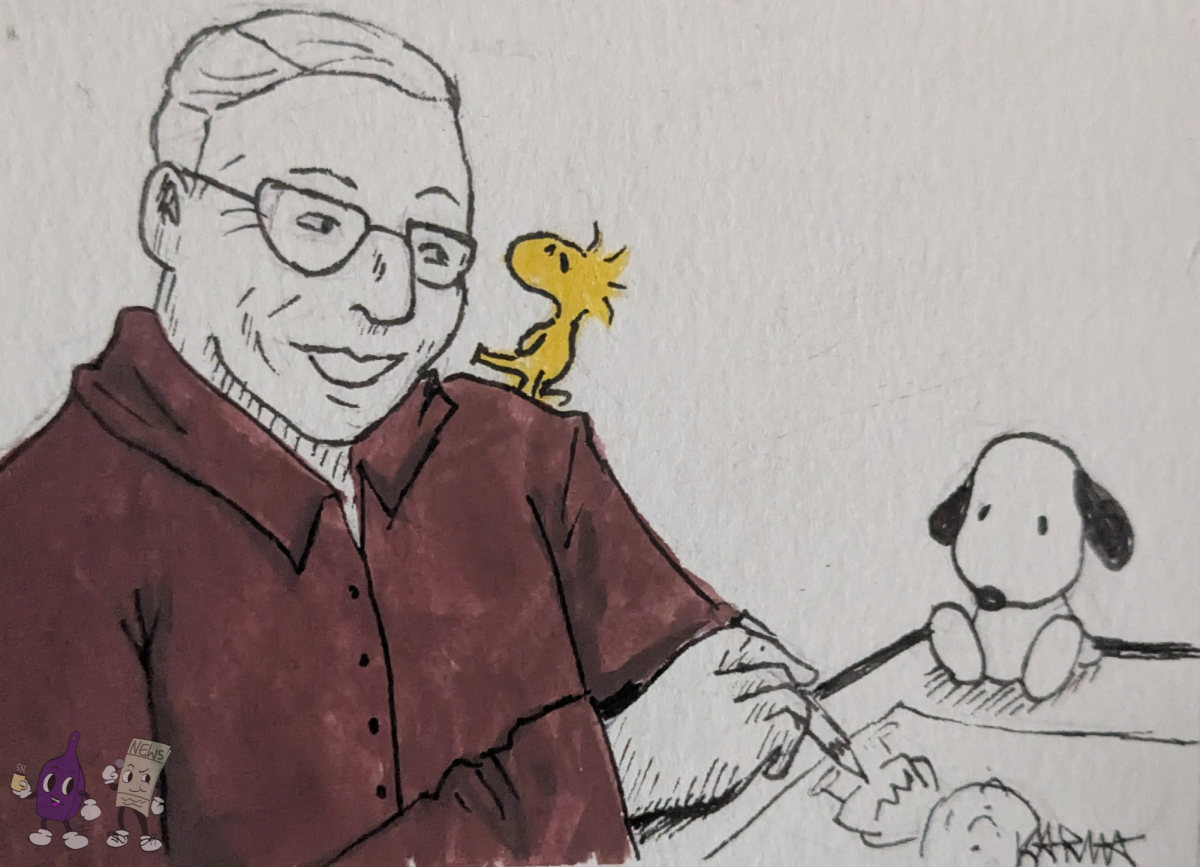Almost everyone has heard of the well known cartoon, Peanuts. It has risen to fame, becoming one of the most popular and influential comic strips in history. But who is behind the comic?
Charles M. Schulz was born on November 26, 1922. From a young age, he, like many kids during that time, loved comic strips such as ‘Spark Plug’, which goes hand in hand with Schulz’s nickname: Sparky. He had also shown an interest in Popeye, Mickey Mouse, and Skippy. Schulz was always artistically talented. He was always getting compliments on his drawings, and when he was fourteen years old, a drawing of his family dog, Spike, was published in the 1937 version of Ripley’s Believe it or Not feature. The illustrator had a specialty, and everyone around him knew it, including the young artist himself.
After graduating in 1940 from St. Paul’s Central High School, he went to take courses at the Art Instruction school in Minneapolis. However, in 1939, the second World War began, and the United States Army drafted approximately ten million people in the six years of fighting, with one of them being Charles Schulz in 1942. Schulz and thousands of other young men were drafted into the war, trained into the Twentieth Armored Division, and sent off to Europe to fight for their country with pride. Luckily, the artist survived the battles, but there were more battles to come when he was discharged and returned home.
Schulz first came up with the idea of the comic strip when he was suffering from depression along with PTSD. Most ex-soldiers had dealt with the same case, but a different outcome occurred. After soldiers had been discharged, it was common for them to suffer from depression and PTSD that led them to take their own lives. Schulz hadn’t only been dealing with depression, but everyday life frustrations. He decided to create a comic strip in order to get rid of these feelings. He not only wanted to show off his talent or let it be a fun hobby, but he wanted to incorportate real life situations into his cartoons.
There are many little hidden factors and ideas that all came together to make Schulz’s dream come true, one of them being that children can go through hard times and face the same hardships as adults.
Schulz put a lot of thought into his creations and characters, with every strip being another issue and each character representing different emotions, personality disorders, characteristics or people he had crossed paths with. Schulz wanted to see himself through the main character, Charlie Brown; an innocent, lonely, misunderstood kid with a good heart whose only wish was to earn a little recognition.
Charlie Brown is an ‘every-man’. He’s sensitive and bland with intellectual curiosity and bravery that lets him get out of his comfort zone. Charlie is there to show other children that it’s okay to be afraid but not to let the fear control you. He expressed his worries when going on adventures with his friends but still faced the challenges.
Charlie’s younger sister, Sally, is a loving person with high energy. She’s lighthearted towards everyone but especially confident with her crush, Linus.
Charlie’s dog, Snoopy, first appeared two days after the debut of the comic and then ended up being rescued by Charlie Brown when he went to Daisy Hill Puppy Farm. Snoopy represents the idea that imagination has power, and that having big dreams can take you anywhere. Snoopy also shows that it pays off to be a good friend.
Charlie’s best friend, Linus Van Pelt, is cautious and loves to follow the rules and orders given to him. He had grown sympathetic towards Charlie and offered advice throughout the entire comic; something only a true best friend can do. Lucy is Linus’ older sister. She has created a Psychiatric Help Booth, she gives advice to her clients that pay five cents. Even though she wants to gain profit, her advice is helpful to those who come looking for advice. Lucy is determined with a guy she likes, Schroeder, and her character demonstrates that strength, along with independence, can work if you’re sensitive as well. She has a soft spot but is still sarcastic and bossy.
Many more characters in the series represent different emotions or personality traits. Schulz had to work hard in order to come up with the characters and what they would mean in the strip as well as many other challenges in the creation.
Before Schulz’s comic got printed in the newspaper, he went to United Features Syndicate (UFS) to pitch his ideas. Although the company loved the idea and were interested, they did not love the name of the comic which was originally “L’il Folks”. They and the artist ran into some issues as the company stated that the name sounded too much like other comics such as “Little Folks” and “Li’l Abner”. A production manager that worked for the company pitched the name ”Peanuts”, a name that will be remembered forever. Many people believe that the name was set since the beginning of the comic’s creation, but it was actually a last resort to fix possible problems when publishing.
In 1947, Howdy Doody, a popular TV show among kids, was reaching its popularity fast. In Howdy Doody, an area was designated for kids to sit during its live broadcasting. The seating area for kids was formally named the “Peanut Gallery” where those kids would laugh and watch the live show. With the area being called the peanut gallery, the kids were formally named “The Peanuts”. So, because Schulz had created a comic strip starring children, they decided to call it Peanuts. Although everyone else had taken a liking to the name, there was one man who grew a hatred for it.
The creator Schulz had disliked the name for the comic’s entire life. He believed that it didn’t make any sense with the story. UFS continued to reject Schulz’s ideas of anything other than the name Peanuts. Schulz advocated for changing it to “Good ‘Ol Charlie Brown” up until the year of his death. Schulz disliked the name so much that most of his drawing titles don’t include Peanuts; they usually include Charlie Brown or Snoopy: “ A Charlie Brown Christmas”, “The Easter Beagle”, and more.
However, as the comic was published, not much attention was gained until the 60s where it was considered to be in its “Golden age”. Over the years the popularity of the story-line and characters spiked as merchandise began to fly off the shelves and DVD specials came out.
Peanuts has only debuted in seven newspapers across Minneapolis, Washington, Colorado, Seattle, Arizona, and Pennsylvania during October in 1950. Over the course of its running (1950- 2000), it skyrocketed to approximately 2,600 newspapers that were spread throughout seventy-five countries in twenty-one different languages in the span of years.
In more recent years, social media has taken a toll on the comic strip. It’s been influencing others to watch, read, and show off the adorable merchandise. The story-line is becoming more known, with the comic being put into series since the 1970s until today with its most recent theater debut in 2015.
There had been an addition to the Peanuts history, with two history museums of comic making. One being in Santa Rosa, California, which opened in 2002. It shows a walk in the past of Charles M. Schulz and his comic strip. It also has a wide variety of original artworks created for the comic strip, adding to the collection of dedication to the artist.
Another museum is located in Machida, Japan, and the entire exhibition is dedicated to the comic’s imaginative, sassy beagle. There’s sculptures outside of the famous dog, and the original drawings of him as well. The museum, too, wants to spread people’s love for the comic strip.
Schulz had dedicated his life to expressing his feelings through drawings. Ultimately, making seven strips per week from its beginning to end of publishing, which totals to approximately 18,000 strips, making Peanuts possibly the longest story ever told. The cartoonist’s legacy will continue on, but without anything new, we can only look back on the past with happiness as people remember hearing about Peanuts for the very first time.
Charles M. Schulz died on February 12, 2000, a few hours before his very last original strip that would be published in all newspapers that Sunday. On that comic strip would be his official words of retirement, which included his wish that he didn’t want nor wish for Peanuts to be continued by anyone else. The artist wished to have sole credit for his work and ideas, which would continue to entertain children for years to come.
Schulz’s wish has been granted now that he’s passed, with people remembering how truly talented the man was. Fans are impressed with Schulz’s ability to put real life situations of children into drawings, but not only that, they’re shocked that an only child could put together realistic sibling relationships. It truly represents his capabilities and talent.
Peanuts has been gaining back its recognition and popularity after some users on TikTok have shared merchandise that they found from Marshalls, Tj Maxx, and Ross. TikTok users have also been making videos on visiting the museums and clips from all of the Peanuts shows, displaying how funny and entertaining the shows have been. The comic strip has been adapted into TV shows. Short stories of Snoopy have been shared on Apple TV and Youtube, and there has even been an animated movie released in 2017. The specials are available on Apple TV and Amazon Prime. All credit has been given to Schulz, and everything that is turning into a show is from a comic strip that the artist had already created, giving Schulz his one last wish of being recognized.




